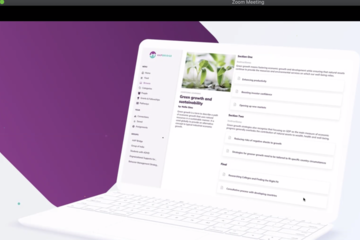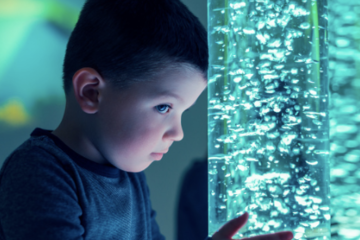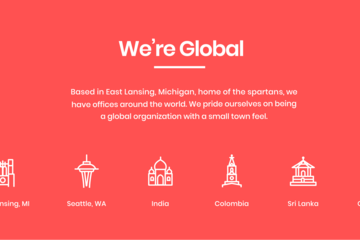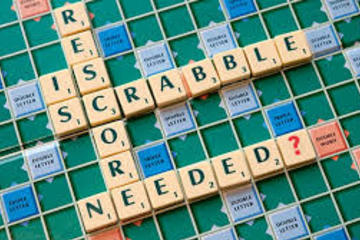We found 197 results that contain "digital learning"
Posted on: #iteachmsu


Communication to Support Student Learning in a Digital Learning Environment
Educator provides evidence of their understanding of communication and outlines and provides evidence of a lesson that uses technology to support students’ use of communication in learning.
Posted on: #iteachmsu


Communication to Support Student Learning in a Digital Learning Environment
What is communication (and what isn’t it)?
The P21 framework emphasizes effective use of oral, written, and nonverbal communication skills for multiple purposes (e.g., to inform, instruct, motivate, persuade, and share ideas). It also focuses on effective listening, using technology to communicate, and being able to evaluate the effectiveness of communication efforts—all within diverse contexts (adapted from P21). Note that working in partners is a great way to collaborate or build shared understanding but a critical part of communication is sharing with an authentic audience.
The P21 framework emphasizes effective use of oral, written, and nonverbal communication skills for multiple purposes (e.g., to inform, instruct, motivate, persuade, and share ideas). It also focuses on effective listening, using technology to communicate, and being able to evaluate the effectiveness of communication efforts—all within diverse contexts (adapted from P21). Note that working in partners is a great way to collaborate or build shared understanding but a critical part of communication is sharing with an authentic audience.
ASSESSING LEARNING
Posted on: #iteachmsu


Communication to Support Student Learning in a Digital Learning Environment
Educator provides evidence of their understanding of communication and outlines and provides evidence of a lesson that uses technology to support students’ use of communication in learning.
Posted on: #iteachmsu

Creativity to Support Student Learning in a Digital Learning Environment
The 4Cs for 21st century learning are Creativity, Critical Thinking, Communication, and Collaboration. They are part of the framework for 21st Century Learning and are designed to support student learning in today’s world and are skills they can use in college and career.
ASSESSING LEARNING
Posted on: #iteachmsu


Creativity to Support Student Learning in a Digital Learning Env
The 4Cs for 21st century learning are Creativity, Critical Thinking, Communication, and Collaboration. They are part of the framework for 21st Century Learning and are designed to support student learning in today’s world and are skills they can use in college and career.
ASSESSING LEARNING
Posted on: #iteachmsu


Digital Collaborative Learning for the 21st Century 2.0 (Learning Community for AY2023-2024)
Chapter 4. Community: The Hidden Context for Learning
Deborah J. Bickford and David J. Wright
University of Dayton
This chapter focuses on a powerful context for learning: community. Community catalyzes deep learning and should be a critical consideration when planning physical and virtual learning spaces.
Deborah J. Bickford and David J. Wright
University of Dayton
This chapter focuses on a powerful context for learning: community. Community catalyzes deep learning and should be a critical consideration when planning physical and virtual learning spaces.
NAVIGATING CONTEXT
Posted on: #iteachmsu

Support Student Learning in a Digital Learning Environment
Educator provides evidence
of their understanding of communication and outlines and provides evidence of a lesson that uses technology to support students’ use of communication in learning.
Method Components
What are the 4Cs?
The 4Cs for 21st century learning are Creativity, Critical Thinking, Communication, and Collaboration. They are part of the framework for 21st Century Learning and are designed to support student learning in today’s world and are skills they can use in college and career.
What is communication (and what isn’t it)?
The P21 framework emphasizes effective use of oral, written, and nonverbal communication skills for multiple purposes (e.g., to inform, instruct, motivate, persuade, and share ideas). It also focuses on effective listening, using technology to communicate, and being able to evaluate the effectiveness of communication efforts—all within diverse contexts (adapted from P21). Note that working in partners is a great way to collaborate or build shared understanding but a critical part of communication is sharing with an authentic audience.
Example strategies that use technology to support communication in the classroom:
Host a TED-style conference or showcases for your students to present original ideas on a topic of interest to them to an authentic, external audience. Record and post the videos to a youtube stream.
Provide opportunities to listen and ask questions through back channel tools like Today’s Meet or even Twitter.
Have your students publish their work through blogs, by creating websites, and by building other online resources that are shared with authentic audiences.
For other ideas see the resources below.
of their understanding of communication and outlines and provides evidence of a lesson that uses technology to support students’ use of communication in learning.
Method Components
What are the 4Cs?
The 4Cs for 21st century learning are Creativity, Critical Thinking, Communication, and Collaboration. They are part of the framework for 21st Century Learning and are designed to support student learning in today’s world and are skills they can use in college and career.
What is communication (and what isn’t it)?
The P21 framework emphasizes effective use of oral, written, and nonverbal communication skills for multiple purposes (e.g., to inform, instruct, motivate, persuade, and share ideas). It also focuses on effective listening, using technology to communicate, and being able to evaluate the effectiveness of communication efforts—all within diverse contexts (adapted from P21). Note that working in partners is a great way to collaborate or build shared understanding but a critical part of communication is sharing with an authentic audience.
Example strategies that use technology to support communication in the classroom:
Host a TED-style conference or showcases for your students to present original ideas on a topic of interest to them to an authentic, external audience. Record and post the videos to a youtube stream.
Provide opportunities to listen and ask questions through back channel tools like Today’s Meet or even Twitter.
Have your students publish their work through blogs, by creating websites, and by building other online resources that are shared with authentic audiences.
For other ideas see the resources below.
Authored by: NC state
Disciplinary Content
Posted on: #iteachmsu


Support Student Learning in a Digital Learning Environment
What is communication (and what isn’t it)?
The P21 framework emphasizes the effective use of oral, written, and nonverbal communication skills for multiple purposes (e.g., to inform, instruct, motivate, persuade, and share ideas). It also focuses on effective listening, using technology to communicate, and being able to evaluate the effectiveness of communication efforts—all within diverse contexts (adapted from P21). Note that working in partners is a great way to collaborate or build shared understanding but a critical part of communication is sharing with an authentic audience.
Example strategies that use technology to support communication in the classroom:
Host a TED-style conference or showcases for your students to present original ideas on a topic of interest to them to an authentic, external audience. Record and post the videos to a youtube stream.
Provide opportunities to listen and ask questions through backchannel tools like Today’s Meet or even Twitter.
Have your students publish their work through blogs, by creating websites, and by building other online resources that are shared with authentic audiences.
For other ideas see the resources below.
https://youtu.be/KUM4AECEcUA
The P21 framework emphasizes the effective use of oral, written, and nonverbal communication skills for multiple purposes (e.g., to inform, instruct, motivate, persuade, and share ideas). It also focuses on effective listening, using technology to communicate, and being able to evaluate the effectiveness of communication efforts—all within diverse contexts (adapted from P21). Note that working in partners is a great way to collaborate or build shared understanding but a critical part of communication is sharing with an authentic audience.
Example strategies that use technology to support communication in the classroom:
Host a TED-style conference or showcases for your students to present original ideas on a topic of interest to them to an authentic, external audience. Record and post the videos to a youtube stream.
Provide opportunities to listen and ask questions through backchannel tools like Today’s Meet or even Twitter.
Have your students publish their work through blogs, by creating websites, and by building other online resources that are shared with authentic audiences.
For other ideas see the resources below.
https://youtu.be/KUM4AECEcUA
Authored by: Friday Institute at NC State
Navigating Context
Posted on: #iteachmsu


Communication to Support Student Learning in a Digital Learning Environment
Key Method
Educator provides evidence of their understanding of communication and outlines and provides evidence of a lesson that uses technology to support students’ use of communication in learning.
Method Components
What are the 4Cs?
The 4Cs for 21st century learning are Creativity, Critical Thinking, Communication, and Collaboration. They are part of the framework for 21st Century Learning and are designed to support student learning in today’s world and are skills they can use in college and career.
What is communication (and what isn’t it)?
The P21 framework emphasizes effective use of oral, written, and nonverbal communication skills for multiple purposes (e.g., to inform, instruct, motivate, persuade, and share ideas). It also focuses on effective listening, using technology to communicate, and being able to evaluate the effectiveness of communication efforts—all within diverse contexts (adapted from P21). Note that working in partners is a great way to collaborate or build shared understanding but a critical part of communication is sharing with an authentic audience.
Educator provides evidence of their understanding of communication and outlines and provides evidence of a lesson that uses technology to support students’ use of communication in learning.
Method Components
What are the 4Cs?
The 4Cs for 21st century learning are Creativity, Critical Thinking, Communication, and Collaboration. They are part of the framework for 21st Century Learning and are designed to support student learning in today’s world and are skills they can use in college and career.
What is communication (and what isn’t it)?
The P21 framework emphasizes effective use of oral, written, and nonverbal communication skills for multiple purposes (e.g., to inform, instruct, motivate, persuade, and share ideas). It also focuses on effective listening, using technology to communicate, and being able to evaluate the effectiveness of communication efforts—all within diverse contexts (adapted from P21). Note that working in partners is a great way to collaborate or build shared understanding but a critical part of communication is sharing with an authentic audience.
Authored by: Greg
Assessing Learning
Posted on: #iteachmsu


Digital Collaborative Learning for the 21st Century 2.0 (Learning Community for AY2023-2024)
Digital Collaborative Learning for the 21st Century 2.0 (Learning Community for AY2023-2024)
Authored by: 906
Disciplinary Content
Posted on: #iteachmsu


Digital Education
K-12 combines technology with education to create high quality and customised learning syllabus for the students from kindergarten to 12th class. K-12 powered online schools are slowly gaining acceptance as it creates a beautiful blend between traditional education with modern technology and tools for digital learning.
K-12 combines technology with education to create high quality and customised learning syllabus for the students from kindergarten to 12th class. K-12 powered online schools are slowly gaining acceptance as it creates a beautiful blend between traditional education with modern technology and tools for digital learning.
K-12 combines technology with education to create high quality and customised learning syllabus for the students from kindergarten to 12th class. K-12 powered online schools are slowly gaining acceptance as it creates a beautiful blend between traditional education with modern technology and tools for digital learning.
Authored by: Divya Sawant
Posted on: #iteachmsu


Cooperative Learning
Carefully structured cooperative learning groups in which each student is assigned a role and has clear expectations for desired outcomes are very helpful for students with ADHD. The more structured the cooperative activity, the more likely it is that these students will succeed.
Posted by: Chathuri Super admin..
Disciplinary Content
Posted on: #iteachmsu

Cooperative Learning
Carefully structured cooperative learning groups in which each student is assigned a role and has clear expectations for desired outcomes are very helpful for students with ADHD. The more structured the cooperative activity, the more likely it is that these students will succeed.
Authored by: Chathu
Disciplinary Content
Posted on: #iteachmsu


Teaching and Learning in Early Childhood Education and Care
Early education ensures free, integral and harmonious development of the child's personality, according to his rhythm and needs. The education provided has to ensure the differentiated stimulation of children, aiming the intellectual, emotional, social and physical development of each child and targeting to achieve the following results of early education (from birth to 6/7 years old):
The free, integral and harmonious development of the child's personality, according to his own pace and general needs, supporting his autonomous and creative training.
Development of the capacity to interact with other children, with adults and with the environment to acquire new knowledge, skills, attitudes and behaviours; encouraging exploration, exercises, tests and experiments, as autonomous learning experiences.
The discovery, by each child, of his/her own identity and autonomy and the development of a positive self-image.
Supporting the child in the acquisition of knowledge, abilities, skills and attitudes required for his school entry and throughout life.
All activities with young children should respect child's right to play - viewed as a form of activity, method, procedure and means of achieving educational approaches at early ages, as well as a method of stimulating the capacity and creativity of the child, as a right of him and as an opening to freedom to choose, according to his/her own needs.
The free, integral and harmonious development of the child's personality, according to his own pace and general needs, supporting his autonomous and creative training.
Development of the capacity to interact with other children, with adults and with the environment to acquire new knowledge, skills, attitudes and behaviours; encouraging exploration, exercises, tests and experiments, as autonomous learning experiences.
The discovery, by each child, of his/her own identity and autonomy and the development of a positive self-image.
Supporting the child in the acquisition of knowledge, abilities, skills and attitudes required for his school entry and throughout life.
All activities with young children should respect child's right to play - viewed as a form of activity, method, procedure and means of achieving educational approaches at early ages, as well as a method of stimulating the capacity and creativity of the child, as a right of him and as an opening to freedom to choose, according to his/her own needs.
Posted by: Chathuri Hewapathirana
Posted on: #iteachmsu
Digital Collaborative Learning for the 21st Century 2.0 (Learning Community for AY2023-2024)
https://www.youtube.com/watch?v=nMxqEkg3wQ0
This talk was a given at a local TEDx event, produced independently of the TED Conferences. Peter is a school principal with a radical solution, no school bell...
This talk was given at a local TEDx event, produced independently of the TED Conferences. Peter is a school principal with a radical solution, no school bell, no school levels, staff selection and curriculum is even decided by students. Result? No bullying, collaboration, innovation in school dynamics. Peter Hutton hated his own school experience, where he felt that education was being done “to him”. As Principal of Templestowe College he developed an educational model that allows students to individualize their education and share control in the running of the school. About TEDx, x = independently organized event In the spirit of ideas worth spreading, TEDx is a program of local, self-organized events that bring people together to share a TED-like experience. At a TEDx event, TEDTalks video and live speakers combine to spark deep discussion and connection in a small group. These local, self-organized events are branded TEDx, where x = independently organized TED event. The TED Conference provides general guidance for the TEDx program, but individual TEDx events are self-organized.* (*Subject to certain rules and regulations)
https://www.youtube.com/watch?v=nMxqEkg3wQ0
This talk was a given at a local TEDx event, produced independently of the TED Conferences. Peter is a school principal with a radical solution, no school bell...
This talk was given at a local TEDx event, produced independently of the TED Conferences. Peter is a school principal with a radical solution, no school bell, no school levels, staff selection and curriculum is even decided by students. Result? No bullying, collaboration, innovation in school dynamics. Peter Hutton hated his own school experience, where he felt that education was being done “to him”. As Principal of Templestowe College he developed an educational model that allows students to individualize their education and share control in the running of the school. About TEDx, x = independently organized event In the spirit of ideas worth spreading, TEDx is a program of local, self-organized events that bring people together to share a TED-like experience. At a TEDx event, TEDTalks video and live speakers combine to spark deep discussion and connection in a small group. These local, self-organized events are branded TEDx, where x = independently organized TED event. The TED Conference provides general guidance for the TEDx program, but individual TEDx events are self-organized.* (*Subject to certain rules and regulations)
Posted by: Chathuri Super admin..
Assessing Learning
Posted on: #iteachmsu


Digital and Comprehensive Online Assessments
Evaluation of students is one of the key areas of academic curriculum. Success of education largely depends on type of evaluation done. Traditionally, the evaluation of the students has largely been focused on theory examinations. The students are analysed based on their theoretical knowledge. The students usually write theory or descriptive answers in the exams and it is being evaluated by one of the examiners. Their passing or failure depends on their understanding of theory.
Evaluation of students is one of the key areas of academic curriculum. Success of education largely depends on type of evaluation done. Traditionally, the evaluation of the students has largely been focused on theory examinations. The students are analysed based on their theoretical knowledge. The students usually write theory or descriptive answers in the exams and it is being evaluated by one of the examiners. Their passing or failure depends on their understanding of theory.
Posted by: Chathuri Super admin..
Assessing Learning
Posted on: #iteachmsu

Digital image processing deals with manipulation of digital images through a digital computer. It is a subfield of signals and systems but focus particularly on images. DIP focuses on developing a computer system that is able to perform processing on an image. The input of that system is a digital image and the system process that image using efficient algorithms, and gives an image as an output. The most common example is Adobe Photoshop. It is one of the widely used application for processing digital images
Posted by: Super Admin
Disciplinary Content
Posted on: #iteachmsu

11 Digital Education Tools For Teachers And Students ...elearningindustry.com › Articles
Mar 31, 2018 — The Most Popular Digital Education Tools For Teachers And Learners · Edmodo is an educational tool that connects teachers and students, and ...
11 Digital Education Tools For Teachers And Students ...elearningindustry.com › Articles
Mar 31, 2018 — The Most Popular Digital Education Tools For Teachers And Learners · Edmodo is an educational tool that connects teachers and students, and ...
Posted by: Chathuri Hewapathirana
Disciplinary Content
Posted on: #iteachmsu

Reinforcement Learning
Reinforcement learning is a subfield of machine learning in which systems are trained by receiving virtual "rewards" or "punishments," essentially learning by trial and error. Google's DeepMind has used reinforcement learning to beat a human champion in the Go games. Reinforcement learning is also used in video games to improve the gaming experience by providing smarter bot.
One of the most famous algorithms are:
Q-learning
Deep Q network
State-Action-Reward-State-Action (SARSA)
Deep Deterministic Policy Gradient (DDPG)
Reinforcement learning is a subfield of machine learning in which systems are trained by receiving virtual "rewards" or "punishments," essentially learning by trial and error. Google's DeepMind has used reinforcement learning to beat a human champion in the Go games. Reinforcement learning is also used in video games to improve the gaming experience by providing smarter bot.
One of the most famous algorithms are:
Q-learning
Deep Q network
State-Action-Reward-State-Action (SARSA)
Deep Deterministic Policy Gradient (DDPG)
Posted by: Chathuri Super admin..
Navigating Context
Posted on: #iteachmsu

Learning a new language this year? This app gets you speaking in just 3 weeks
Anyone can speak a language with Babbel, even if you’re a complete beginner who has never attempted to learn a language before. Here are 5 reasons why there’s nothing holding you back from learning a new language with Babbel.
Anyone can speak a language with Babbel, even if you’re a complete beginner who has never attempted to learn a language before. Here are 5 reasons why there’s nothing holding you back from learning a new language with Babbel.
Posted by: Greg Thomsan
Assessing Learning
Host: MSU Libraries

Intro to 360 Cameras, 3D Scanners, & Other Digitization Equipment @ DSL: Drop-in Session
Immersive data is everywhere. It's in every digital asset you see in a video game, a YouTube 360 video and the panoramic pictures you take with your mobile device. Drop in to learn about how 360 cameras, 3D scanners and our digitization equipment is used to create these new experiences and apply them to your research, assignments and presentations.
Navigating Context
Host: MSU Libraries

Learn QGIS: Making a color shaded map in QGIS (Online)
Learn the basics of QGIS, the free open-source geospatial software—this workshop will demonstrate how to make a choropleth (color shaded) map and place graduated symbols representing data on it, load shape-files and .csv table files into QGIS, join data to spatial information and edit features. No experience with QGIS or Geographic Information Systems is required.
Navigating Context





